A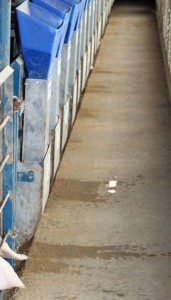 couple of weeks ago I received a call from Fritz Richards, Hog Slat’s national sales manager. Next time you are in North Carolina we need to run out to TDM #29 and take a look at the way they are utilizing a SowMAX feeder for feeding weaned sows.” It just so happened I was going to be in North Carolina the following week so I met Fritz at his office and we set out for the farm. As we drove he filled me in. “They have adapted 30 of the breeding row stalls with small bowl feeders and SowMAX dispensers mounted in the front gate. It’s giving them a chance to compare the results against the other 70 stalls that are fed by the standard method.” “What is the thinking behind that?" I asked. “They know that if they can increase the energy intake of a sow from weaning to first service they will get production benefits. The problem has been it’s tough to increase consumption without over feeding and wasting feed. With the high cost of feed it’s more important than ever to feed sows correctly without wastage.” “We have had several industry production advisors through the farm recently and they were very positive about what they saw.” We showered into the farm and happened to catch the unit manager, Britt Hooper and his staff during their morning break. Fritz spoke with Britt about his early experiences with the SowMAX test. To view a video of his observations please go to http://hogslat.com/sowmax-feed-dispenser
couple of weeks ago I received a call from Fritz Richards, Hog Slat’s national sales manager. Next time you are in North Carolina we need to run out to TDM #29 and take a look at the way they are utilizing a SowMAX feeder for feeding weaned sows.” It just so happened I was going to be in North Carolina the following week so I met Fritz at his office and we set out for the farm. As we drove he filled me in. “They have adapted 30 of the breeding row stalls with small bowl feeders and SowMAX dispensers mounted in the front gate. It’s giving them a chance to compare the results against the other 70 stalls that are fed by the standard method.” “What is the thinking behind that?" I asked. “They know that if they can increase the energy intake of a sow from weaning to first service they will get production benefits. The problem has been it’s tough to increase consumption without over feeding and wasting feed. With the high cost of feed it’s more important than ever to feed sows correctly without wastage.” “We have had several industry production advisors through the farm recently and they were very positive about what they saw.” We showered into the farm and happened to catch the unit manager, Britt Hooper and his staff during their morning break. Fritz spoke with Britt about his early experiences with the SowMAX test. To view a video of his observations please go to http://hogslat.com/sowmax-feed-dispenser
Blog posts tagged with 'gestation'
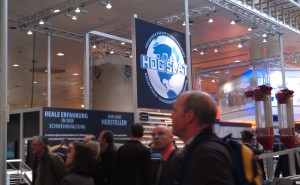 Billed as the world’s top event for animal production, EuroTier was held this past week in Hanover, Germany. Producers from across the world attend EuroTier and for many it was their first exposure to American style production equipment as exhibited by Hog Slat.
Billed as the world’s top event for animal production, EuroTier was held this past week in Hanover, Germany. Producers from across the world attend EuroTier and for many it was their first exposure to American style production equipment as exhibited by Hog Slat.
We spoke with Hog Slat’s European sales manager, Kirk Brincks and asked about international producers comments concerning the equipment. He replied, “ Their general reaction is Hog Slat builds durable products that represent a good value. They like the common sense design and how it is incorporated into the overall building layout.”
We asked Kirk what particular item was most popular, “ I would have to say the SowMAX dispensers. All producers are facing high feed costs and feed saving equipment is important to them. A customer, with sow farms in the Ukraine and Poland, has installed over 1,000 SowMAX units and is sold on the feed savings.”
He continued, “Another big item of interest is concrete slats. We had many producers who see them for the first time and immediately comment on the quality. I think people tend to view concrete slats as all being kind of the same, but we really do build a slat that will last longer. Experienced producers seemed to recognize it very quickly.”
“And”, he laughed, “they always ask when are we building a slat plant near them”
Kirk finished up with, “The Grower Select line has caught on quickly. We have several production companies that we work with in identifying their high replacement items, providing them easy order forms and stocking those parts for quick delivery. Grower Select just fits with Hog Slat’s basic philosophy of providing producers with a better value for their money……. in this case it’s excellent quality replacement parts that are priced right.”
It’s not news to pork producers that hogs are hard on equipment. Just normal wear and tear will damage even the stoutest equipment.
One tough repair is a loose anchor bolt in concrete walls or floors. Whether it’s a wall bracket, divider panel or gestation stall leg, they can all work loose with the constant “banging” from large hogs. This not an easy repair; typically the anchor has to be removed and the hole drilled either larger or deeper to hold a new stud.
The new EPO-SET 400 makes this repair much easier.
EPO-SET 400 is a two-part polymer especially formulated for repairing loose anchor bolt studs. Simply clean the loose debris out of the hole around the anchor. Place the mixture into the void and it sets up in ten minutes with full strength in two hours.
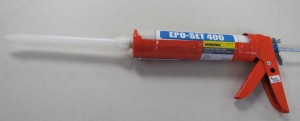
EPO-SET is easy to use because of the unique dual cartridge system for use in a standard caulking gun.
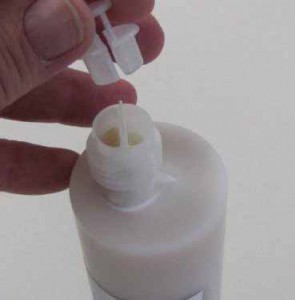
The standard sized tube contains two separate chambers that mix inside the static mixing nozzle. No need to buy an expensive two-tube caulking gun or mix the two parts in a tray before using. Just squeeze the handle and the blended mixture comes out the nozzle. Makes it easy to direct into holes and cracks in concrete.

You can watch our video at http://hogslat.com/epo-set-400 to learn more.
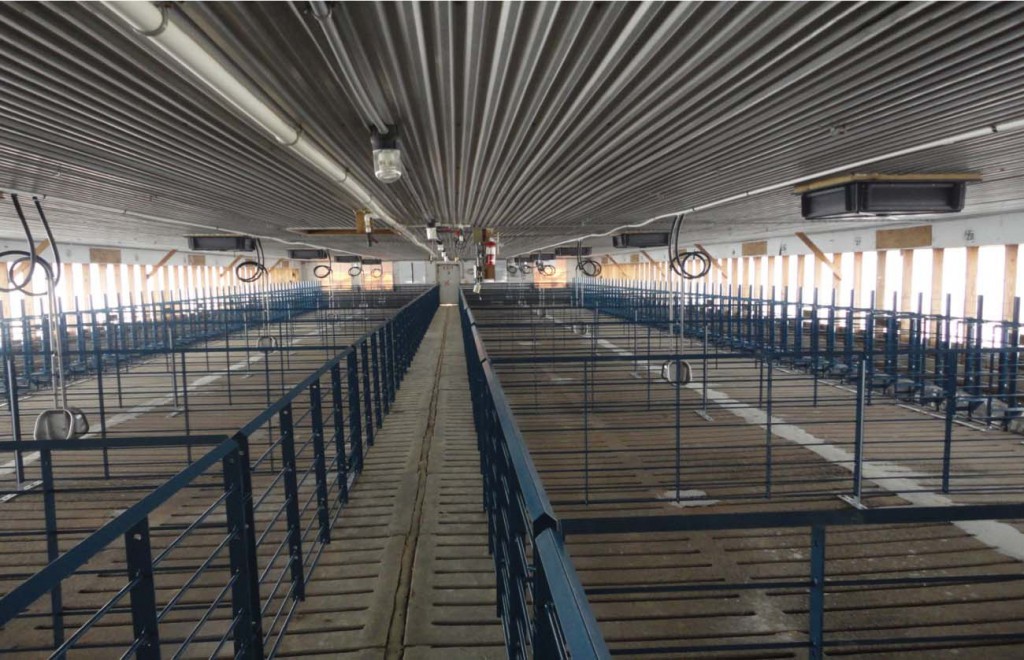
Murphy-Brown’s North Division has completed one of the largest stall to group housing conversions in the industry. All the company farms have been converted to group housing over the last four years; 58,000 sows in total. Keith Allen, General Manager of the North Division, discussed the conversion.
Keith, how did you decide on the type of group system?
“Long before we announced our conversion plans, we toured several types of housing systems abroad; ESF (Electronic Sow Feeding), Free-Access stalls and Pens with feeding stations or Stanchions. We felt stanchions would require the least amount of cost and would be easiest to manage. The results four years post conversion support that decision.”

Can you explain that a little further?
“Our production records validate improvements for any metric you can compare, pig/born, pigs weaned, etc. The company farm production records rank better than most contract growers with stall gestation. Sow mortally is neutral when compared to traditional stall operations in the system. Fighting is less than we expected. Although we anticipated higher feed consumption in gestation, it also has remained neutral.”
Do you manage any other types of group housing systems to compare stanchions to?
“We have a large 10,500-sow unit with ESF feeding stations. The repair and maintenance of the feeding stations requires a full time employee on this operation. There is extra labor involved with the management of the animals. Every day the computer system prints a list of animals that didn’t record entry into the ESF from the previous day. An employee must locate those animals and identify why; Is she sick? Did she lose her tag? Is the feeding station in need of repair? Etc.”
“We just don’t have the extra labor costs or the maintenance in our stanchion type barns.”
“Free access stalls don’t have the same issues, but are more expensive to construct and present an increased opportunity of equipment failure with the gate latching mechanism. There is also a chance an employee inadvertently or purposely could lock the animals in the stalls, and then we really don’t have loose pen housing anymore.”
How did the transition go on the farms?
“The transition was seamless; our employees now prefer stanchions to the stall system we used before.”

What are basic design requirements you used?
“We designed the pens to hold six sows with 24 square feet per animal; there is one feeding stanchion per sow. The stanchions are 24” wide, and the dividers are 18” long. The length of the divider is important; this divider should be long enough to extend past the shoulders. By extending past her shoulder, she feels more comfortable and secure when eating.”
“The facility design provides breeding stalls to house sows for 35 to 42 days post insemination. After preg-checking, sows are grouped by size and moved to the pens.”
“An additional 3-5% of stalls have been added in the Group Housed gestation barns to provide critical care space for any animals that may require extra care or must be removed from the pens.”

Have you made changes to the design over time since beginning the conversion?
“Yes, our original layouts allowed for 7% extra stalls in the group housed gestation barns…..we have since cut that back to only 3-5%.”
“We have also realized it is unnecessary to have an alleyway between rows in group housed gestation. We simply mount the stanchions and sow feed drops head to head. One of the things you lose with group housing is the ability to regulate individual feed intake…..you manage by pens, so there isn’t a lot of adjustment to the drops.”
“We also have added “Access Doors” to the pen dividers to make it easier to walk from pen to pen. These consist of two posts set far enough apart that a person can squeeze through with a swinging solid divider on top to prevent the animals from attempting to go over the opening. We no longer have to climb pen dividers to check sows.”
How have the changes been viewed by Smithfield’s customers?
“I have personally toured many representatives from large food companies through our remodeled facilities. These companies made public commitments to securing pork from “stall-free” producers by a named date….they are listening to the consumer and committed to their long term Sustainability Programs. In every case, the reps remarked how well cared for the animals seemed to be and remarked how clean the facilities were. We think we have answered their concerns with this type of group housing.”
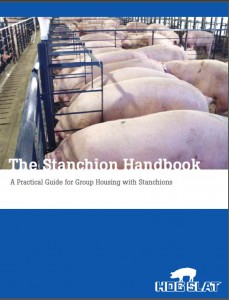
The handbook begins by comparing merits of different systems available for group housing. Complete with illustrated pictures of equipment and diagrams of building layouts, this 16 page handbook contains practical details needed to build new sow housing or convert existing stalls to group housing.
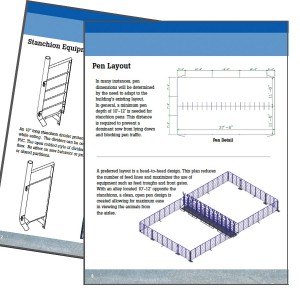
Download your FREE Stanchion Handbook
Located in McLeansboro, IL, L&L Farms began their hog farming operation in 1994 raising 400 sows. Since then, Jeff and his family along with the help of quality employees have grown their breed to wean operation to 4,000 sows housed in 2 locations. We spoke with owner, Jeff Lueke:
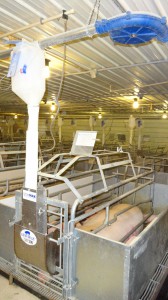 Jeff, you have purchased several Grow-Disk™ systems, why did you decide to install this feeding system?
Jeff, you have purchased several Grow-Disk™ systems, why did you decide to install this feeding system?
I really felt like we were gaining efficiencies in the farrowing department. We saw how it could provide advantages to our employees, allowing them to be more efficient and manage more sows. Within our operation we also set target goals. These goals consisted of narrowing down the wean to first service interval, drive a heavier pig out the door at weaning, and increase lactation length leading to subsequent larger litter sizes for pigs. In our management plan, we felt that these two products, SowMAX and Grow-Disk, would be a big help to reach our target goals by getting more feed to the sows.
How many Grow-Disk™ systems have you installed?
3. All have been installed into our farrowing barns, but I would not hesitate to install them into any application.
How do you use Grow-Disk™ to feed the sows?
We combine the Grow-Disk with the SowMAX. We feel that the combination of these products delivers a very good program. We basically want the sows to have access to full feed. Between these two products we feel that we can deliver that to our sows very efficiently. The system still gives us flexibility to limit feed intake because we include the Sow Drop. The Sow Drop allows us to limit feed intake if we want to, whether it is in early lactation, pre-farrowing, or for the first three days post-farrowing. In post-farrowing we schedule to feed five times throughout the day, in pre-farrowing we schedule to feed twice a day.
How have the Grow-Disk™ systems performed for you? What benefits have you seen?
I have no complaints; I do believe that we are getting more daily feed intake from our sows with the system. The system is hands-off, requiring less labor to feed. With this automatic feeding we are able to keep feed available, and produce less wastage.
Why did you choose Grow-Disk™ instead of a flexible auger system for your project?
My local sales contact, Carl Herrmann, shared with me some of the advantages that Grow-Disk can offer. Knowing that it was a new product, and knowing that I’ve had success with Hog Slat products in the past, it made me anxious to try it. I think its heavy duty, reliable, and I have not been disappointed.
Switching gears, tell us about your routine feeding with SowMAX.
The system that we set up is basically designed to keep feed available for the sow to access at all times, but not have so much feed supply that if there was a malfunction we would have a pit full of feed. The system allows us to make that work. At most any time there’s 12-20 lbs. of feed available to the sow. If that particular sow wants to get up at 6 a.m. and eat 15 pounds of feed, it’s there. If a sow wants to eat five small meals throughout the day she has the opportunity to do that as well. I think that we forget that hogs are somewhat individuals like people, and may all have a little different idea of how they want to eat. In the past when we fed with a scoop and cart, the sows got trained to jump up and eat whenever it was time to feed. Even if a litter of piglets just started nursing, the sow still jumped up to eat. The sows are much more content and apt to eat at their convenience than they are when you decide when it’s time to feed. For daily management of the SowMAX, we clean and make necessary adjustments to the feeders twice a day. We have been able to keep SowMAX feeders cleaner compared to other systems. The feeders are simple and easy to utilize and maintain.
What advantages have you noticed with SowMAX over how you fed sows in the past?
We have been able to accomplish our management goals by incorporating SowMAX into our operation. I do believe we have raised heavier pigs. We have noticed that SowMAX wastes less feed and requires less maintenance compared to a solid tube. Having the ability to keep fresh feed in front of the sow all day has been a great benefit.
Do you use any other Hog Slat equipment?
We incorporate Hog Slat’s concrete slats, penning, boar carts, Sow Drops, farrowing crates, and Tridek flooring, among others into our operation. I’ve found this equipment to meet my standards for over 20 years.
Do you have any suggestions for other hog farmers looking into the GrowerSELECT® product line?
It’s a viable program that should be looked at. I think it is cost efficient for the performance. It would be an asset to any building project.
I was scrolling the web for information on sow housing and ran across this piece authored by John J. McGlone, PhD at Texas Tech University. Here are some highlights:
First mention of sow stalls was in 1807 in Baxter, England.
Lubbock Swine Breeders housed sows in stalls starting in 1964/1965. These stalls featured a sand area behind them.
To read the full article, click the link below:
The Crate (stall, case,cage, box, etc): Its History and Efficacy – John J. McGlone, PhD
I found it to be interesting reading and hope you do too.
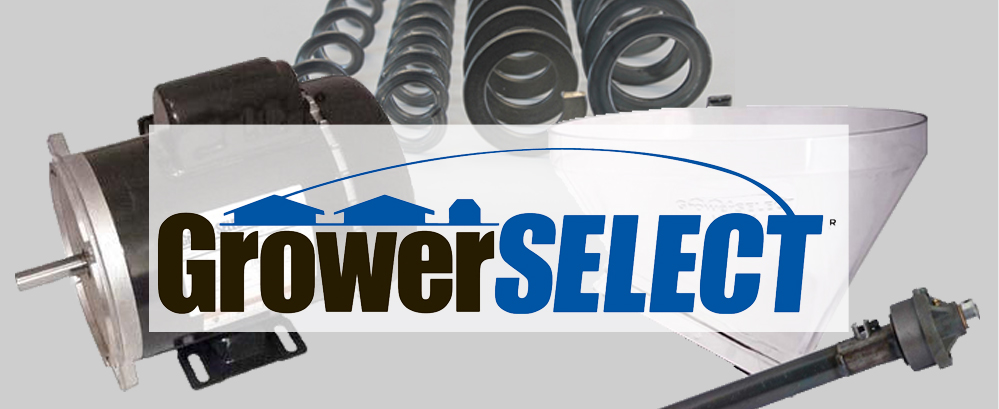
Many producers utilize Grower Select® products to lower their production costs. Paying 30% less for repair parts reduces maintenance costs in livestock or poultry buildings and increases the bottom line.
There may some hesitation by producers to take advantage of these savings because they are not sure which Grower Select® part number to use when repairing Chore-Time® or AP® feed systems.
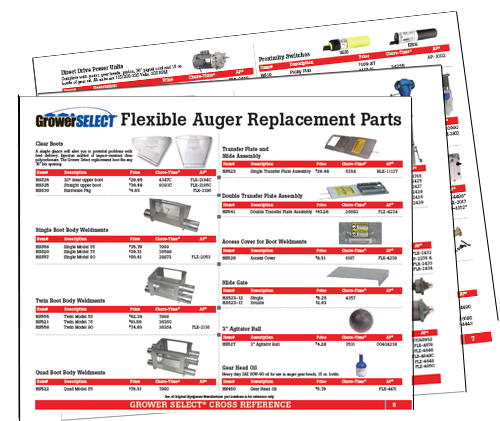
To make the correct selection easier, we have created a new cross reference for Grower Select® feed system parts. Simply find the OEM part number in the list and cross reference to the matching Grower Select® part number. Download the Grower Select® Feed System Parts OEM Cross Reference Sheet.
Our new Fall/Winter catalog also contains the Cross Reference list.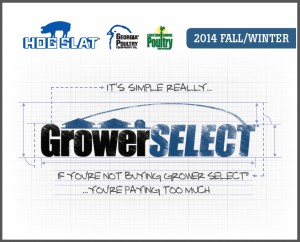
To order a FREE copy online, click on Catalog Request.
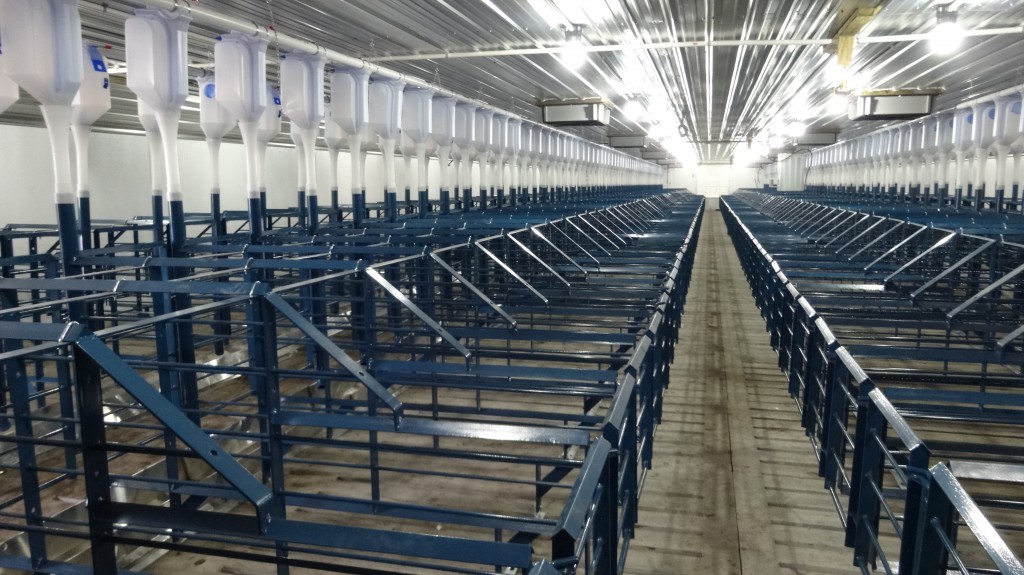
Take a quick video tour of a recently completed swine gestation building located near Hardy, IA. This 41′ X 133′ gestation building houses 260 animals.
The building features a GrowerSELECT® Evap system, GrowerSELECT flag feed system with individual Sow Drops, Hog Slat dry cast slats, Hog Slat gestation stalls and a tunnel ventilation system.
I have been around Hog Slat for some 22 years now. In my opinion, one of Hog Slat’s biggest strengths comes from the company’s ability to take its proven equipment designs and adapt to local production methods.

Hog Slat introduced the concept of total slatted, curtain-sided finishing barns to the Midwest during the late 80’s. Hog Slat quickly changed the ventilation, manure handling and building materials to match local conditions, but the basic concept remained the same. This style of finishing building changed the way pigs were finished in the Midwest resulting in improved pig performance and increased profitability.
A similar situation is developing in Europe with Hog Slat.
Hog Slat’s display at EuroTier showcased a new line of steel equipment tailored to the European swine market. It’s a different type of equipment than you would see Hog Slat display at the World Pork Expo.
The first thing that comes to eye is the hot-dipped galvanized finish vs. the painted finish most common in the U.S. market. Interior space is more confined, and the building layouts reflect in equipment design. And of course EU regulations are followed regarding square footage allowed, penning and flooring design.
Breeding Stall
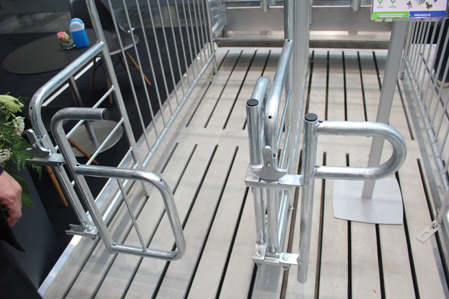
The Breeding stall features a split “saloon-style” back door. The split gate allows the operator to enter the stall while the closed section prevents the sow from backing out.
The gate is designed to operated with only one hand allowing the technician to carry a preg-checker or AI equipment in the other.
Watch a short Video of the saloon doors
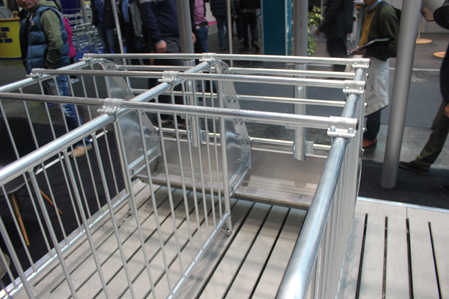
European concrete slats tend to have less open area than slats in the U.S. due to welfare regulations. Stainless steel legs rotate to allow placement of an anchor in a slat opening. A set bolt is tightened to secure the leg to the stall side. Three top and four front bars attached to the stall sides with clamps, making it easier to get a straight installation without drilling or welding.

The stainless steel feed trough will outlast composite or concrete troughs. Because sows can lie with their heads under the raised trough, the overall length can be reduced to 1.8 meters and still meet EU regulations requiring a stall to be 2 meters long.
International Crate
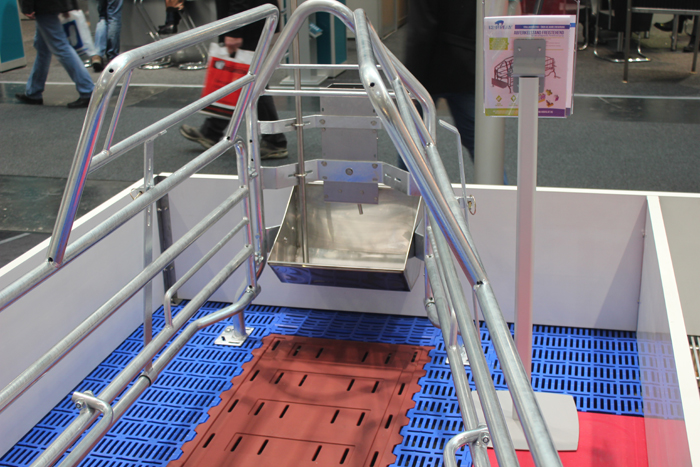
A typical pen layout will have farrowing stalls facing out against the room walls with only a center alleyway.
The combination feed and water trough is raised to allow the sow more effective stall length. Many producers choose to install the SowMAX (read more…..) and fill with an automatic auger or chain disk system as hand feeding is difficult without a front feeding alley.

To load the crates the rear creep panel is opened, the rear gate unfastened and the movable side panel is slid to its open position. After the sow moves into stall, the operator adjusts the movable side to the size of the sow and selects one of the holes in the rear gate to hold it in place. The operator then adjusts the bottom bow bar for large or small sows. The bow bars also include anti-crushing bars to reduce pig mortality.
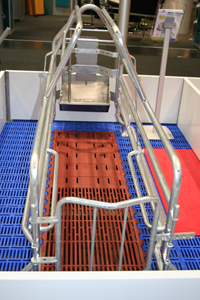
Hog Slat displayed its plastic flooring and with interlocking cast center sections for farrowing. Optional types of flooring sections, including red heating sections, allow producers to design a custom floor. Creep areas are larger than typically used in the U.S. The EuroTier floor measured 1.8 meters (5.9′) wide by 2.4 meters (7.87′) long.

Hog Slat also featured traditional style European penning with PVC planking on the bottom and galvanized pipes fastened to formed stainless steel posts. Notice the plastic fasteners at the end of the pipes, after the pipes are cut to length the plastic ends are forced onto the pipe and bolted into place. U.S. style horizontal penning is also finding some favor with some European producers as it is more cost effective and allows for better ventilation.
Going forward, you will see a constant blend of American and European concepts reflected in the equipment Hog Slat builds for Europe. Hog Slat’s manufacturing, sourcing and distribution expertise will lower the final cost to the producers without sacrificing quality.
U.S. concepts in ventilation (tunnel), feeding (SowMAX), and finishing equipment (open horizontal penning) will gain acceptance with European producers looking for maximum efficiencies in producing pork.
- 2025
- 2024
- 2023
- 2022
- 2021
- 2020
- 2019
- 2018
- 2017
- 2016
- 2015
- 2013












 Україна
Україна Méjico
Méjico


